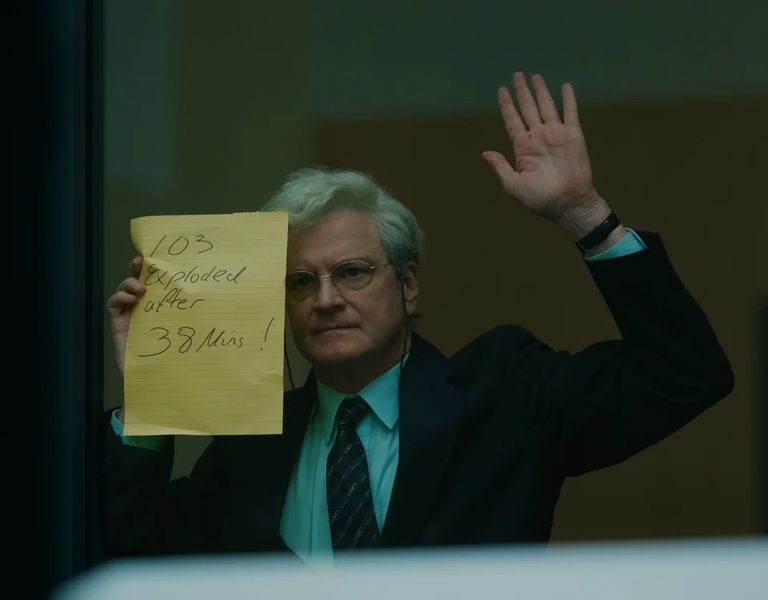
Please share an outline of the production?
Episode 6 was done a satellite from the rest of the series, which we shot after most everything else had been shot by two different DPs. I was onboard solely for episode 6. We shot in the Astra sound stages in Budapest.
How different was the production from previous projects?
For me it was a first. I come from arthouse films and this was a different production. Massive sets and crews, unreal engine, LED volumes, very intricate planning to achieve the goal we set for ourselves. I loved the challenge of it.
How did the director articulate what they were looking for?
Daniel Espinosa and I made a film called Madame Luna just before we embarked on this production, we have a shorthand, he was clear about this being a single take episode which needed to feel like the viewer is one of the robbers. So his vision was clear and our communication as well. Episode 6 was like the cherry on the cake in this series.
How did you decide upon the visual language?
This was in some ways a continuation of the language we had started developing in Madame Luna, very long takes with handheld camera which feel seamless, emotional and absolutely character driven. But we had to take it to the next level with this one, since the whole heist involved a helicopter, ladders, explosions, etc so the shot listing was more complex in regards to the “edit” within the whole shot, because we had to nail it on set and nothing could be changed after.
How did you go about devising the shot list?
We started shot listing 8-9 months prior to production for the whole planning of VFX, volumes, plates, technical equipment, grip and light. Daniel and I just dreamt the whole thing up without thinking of how we were going to do it technically but just approaching it narratively and emotionally, after that the solving of the technical approach came.
What cameras and lenses did you use and why?
I shot with an Alexa Mini LF with customized ALFAs, a 47mm and a 60mm. Again, the same setup we had for Madame Luna but just with two lenses because we had one shot.
How did you go about devising the lighting schemes and what fixtures did you use and why?
For every set I had a different approach to light, I worked with Balasz Vakar as my gaffer. For the rooftop we used a mixture of Creamsource Vortexs (40 units), 360 sky panels (3) and some Asteras and orbiters. Most of the units were running at very low levels, 5-10% of their output. For me this was key to maintain the reality of the environment with the LED volume.
For the atrium set it was mostly practical lights which we see in the frame, the same with the cash depot and the hallway before it. I wanted to move completely freely with the camera so my lighting approach was always as practical as possible with 50-60 Asteras set at different levels in fixtures placed by production design. In the helicopter itself the setup couldn’t have been smaller, I had 4 Helios tubes at very low output levels.
Did you have to create any custom camera and lighting rigs?
I had the need to move the camera in the helicopter cabin which was extremely small. I thought of Children of Men and what Lubezki did back then. Attila, my key grip, built a Children of Men inspired rig with two sliders which was more rough in the movement and supported the handheld feel of the camera in the helicopter. The atrium set was done with a 50foot Technocrane which I operated remotely. For light, Balazs rigged the rooftop set from one main side with the Vortexs.
What challenges did you encounter when shooting the project and how did you overcome those?
There were many challenges, the one shot nature of the episode meant that the planning for it was very complicated, many things to keep in mind and many discussions to be had with VFX, production design and my crew in every regard. On top of that I was operating the whole episode which made the challenges of this endeavoUr even harder, but I loved every minute of it.
How did you decide upon the colour palette and LUTs?
I developed LUTs with my go to colourist in Berlin, Philipp Orgassa at Basis Berlin Post, who I’ve worked with for many years now, also together with Daniel for Madame Luna. The palette for light was very clear, I like the orange nature of sodium vapor and green hues in the halogen tubes fixtures in the cash depot. I usually make things on set as I want them during the DI. I try to always work with Philipp Orgassa at Basis Berlin and we usually grade very fast. Working with him is very easy and we understand each other without words.
Is there particular shot or sequence you are most proud of?
This is a single shot episode, I’m very proud of the whole thing we achieved as a crew, together with my 1st AC, Johannes Päch, who allows me to move the camera as I like without rehearsals or marks, which was pivotal for the controlled chaos of this episode. Also kudos to the VFX crew led by Peter Hjort and Mikael Windelin.
What lessons did this production teach you?
I learned that there is really nothing which can’t be achieved if enough planning, effort, passion and technical know-how comes into the equation. And I also rediscovered that the best work often comes when we are outside of our comfort zones.












